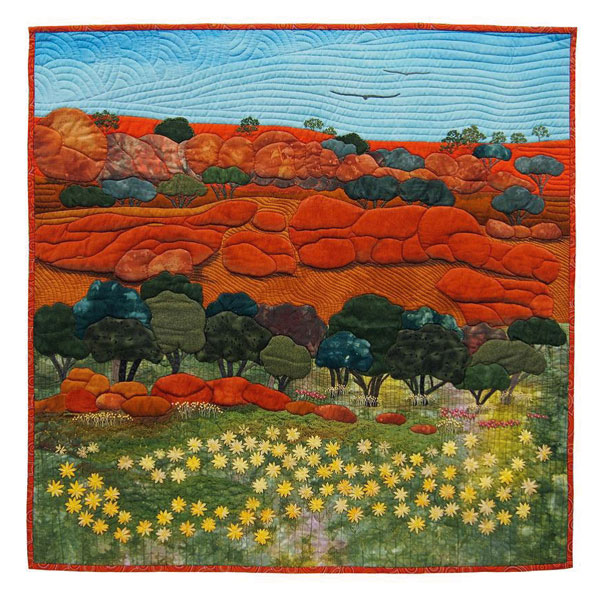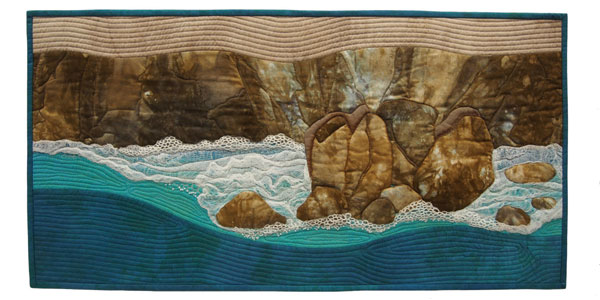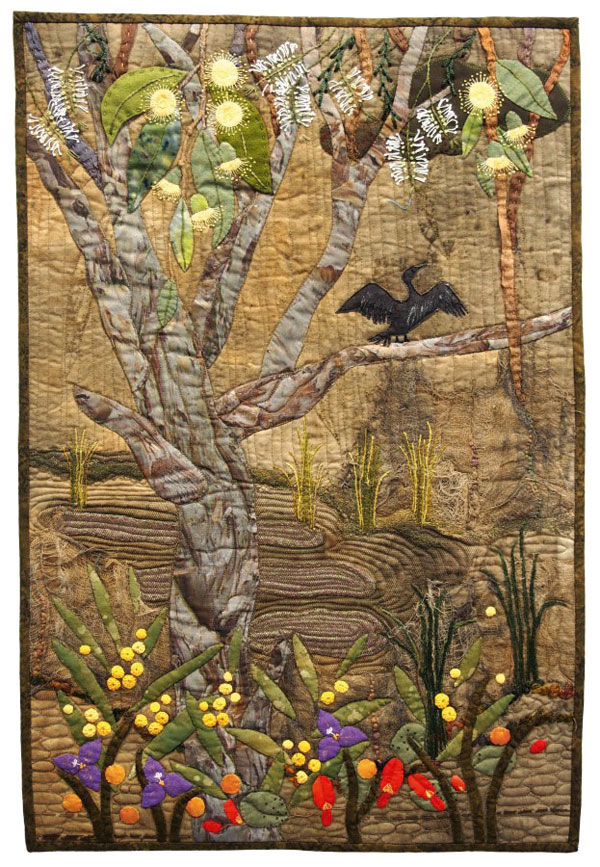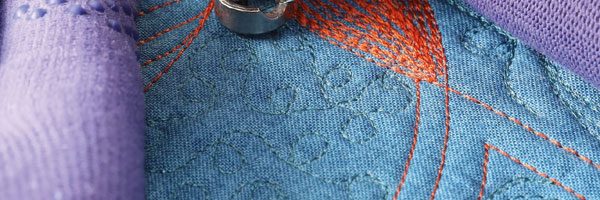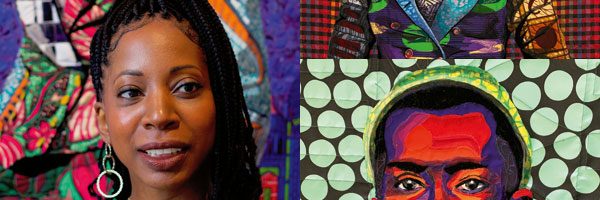
In the Studio of Western Australian-based quiltmaker Elizabeth Humphreys
The mainly self-taught, Western Australian-based quiltmaker, Elizabeth Humphreys, cut her teeth on conventional quilt designs. But over a career spanning 50 years, she has graduated in more recent times to landscape and pictorial quilts depicting the physical and cultural phenomena of her local environment.
Elizabeth started working on her first-ever quilt in 1968 using surplus materials from her dressmaking, and applying sewing skills learned from her mother, who used a Singer treadle machine that had belonged to her mother. It wasn’t until 1975 that she began the first quilt that she actually finished — although completing it did take 17 years! Ambitiously, Elizabeth had decided to adapt a design she had seen in a women’s magazine pieced from hexagons. She made the necessary templates using discarded breakfast cereal boxes. She still has some of them and, as an aside, remarks that they tell an interesting story of dietary changes over the decades, as the family-favourite cereal now contains only half the sugar content of those earlier days when her children were much younger. The hexagons were made from dressmaking scraps: fabric from her maternity dresses, her husband’s shirts, and even from board shorts she made for son #3. The partly assembled quilt travelled widely, with the cardboard and fabric rolled up, and taken from posting to posting during her husband’s military career. It wasn’t until the early 1990s, when she met some quiltmakers who were able to guide her in achieving straight edges on the hexagons, that Elizabeth bought some patchwork fabric, made borders and finished the quilt in 1992.
After her husband retired from the military in 1984, the family settled on an 87-hectare portion of a former farm in the central wheat belt region of Western Australia, where they set about rehabilitating and revegetating the rundown land. This process sparked an interest in local indigenous trees and shrubs, and together with an appreciation of the surrounding terrain, stimulated Elizabeth to pursue distinctly Australian themes in her quiltmaking. This initially manifested itself in adapting quilt patterns to incorporate Australian fabrics and earthy colours and in fashioning appliquéd eucalypt and acacia blossoms. A quilt that Elizabeth finished in 2000 depicted a representation of their farm and became a family favourite. It also marked a transition of sorts, from the making of conventional quilt designs to representations of Western Australian landscapes, flora and fauna, and pictorial quilts imbued with indigenous cultural significance.
An aspect of quiltmaking that Elizabeth finds especially enjoyable is working out how to solve design and technical construction issues. She sometimes uses curved piecing for backgrounds but may also resort to fabric painting. She likes to incorporate appliqué and embroidery techniques where she feels they may shape her design, and she finds herself relying on numerous colonial knots. Fundamental to the success of her designs is the research required to ensure she devises effective portrayals in her designs of the flora, fauna or landscape. Indeed, Elizabeth and her husband have travelled extensively throughout Western Australia, especially through the Mount Magnet area to the north, along the south coast and through the goldfields area around Kalgoorlie, treating these as observational excursions to help form images for her quilts and to absorb the distinctive indigenous cultural influences of the traditional custodians of the land.
Over the years, Elizabeth has contributed to the more general development and acceptance of her craft. Through the Aussie Hero Quilts organisation she has made many quilts for Defence Force personnel serving overseas. On one occasion she made a special quilt for a bereaved couple in memory of their son, lost while serving in Afghanistan. This led to Elizabeth being asked to make an annual quilt for the bereaved families’ group. In 2015, the quilt Elizabeth made as a tribute to the ANZACs was presented to the Governor General in Canberra and now forms part of the Australian War Memorial collection. The planned renovations for the Australian War Memorial to include a gallery for recent military conflicts may well see Elizabeth’s quilt included in that display.
Create your own desert landscape quilt with Caroline Sharkey
Elizabeth is a member of the WA Inspired Art Quilters group making pictorial quilts on various themes. One such quilt portrayed the realistic representation of a major water pipeline in a forested setting, celebrating the long-established Goldfields Water Supply Scheme, which delivers potable water from the Mundaring Weir in Perth to the eastern goldfields, and in particular, Kalgoorlie and Coolgardie. Elizabeth’s pipeline quilt, Close to My Heart, (shown lower left on page 42) was acquired by the Western Australia Water Corporation as one of a set of seven that hang in the corporation’s head office in Perth.
The fabric that Elizabeth used for the pipe came from one of her mother-in-law’s sheet. “She lived in Kalgoorlie, so that sheet would have been washed in pipeline water for an awful lot of years,” Elizabeth said.
Another recent quilt made with this group of quilters, reflecting a coastal landscape theme in an Aboriginal context, was Elizabeth’s portrayal of a segment of the state’s southern coastline. It features the place where the Eyre Highway passes close to the cliffs of the Great Australian Bight, representing the separation of Gondwana from Antarctica over 50 million years ago, an area occupied by the Mirning Aboriginal language group before European settlement. The 80cm x 40cm (19½in x 15¾in) quilt, (shown on page 41), illustrates an ocean view of the cliffs, using hand-dyed fabrics. The fabric for the cliffs and rocks uses a cram jar technique, and the quilt also features needleturn appliqué, sewing machine lace and cotton gauze.
Make the Babbling Banksias Quilt with Dijanne Cevaal’s pattern
The WA Inspired Art Quilters also made a set of quilts in 2019 relating to the wetlands of the Swan Coastal Plains, entitled Whadjuk Noongar Country Wetland Glimpses, which were acquired by the National Museum in Canberra. Two of Elizabeth’s quilts were included. One was Cardacut the Cormorant with Eucalyptus and Melaleuca, signifying the indigenous Nyoongar food gatherers’ belief that the cormorant signified good fishing nearby. As inspiration for her quilt design, Elizabeth used her 2017 photograph of the Marlup Pool in the wetlands. She constructed the 60cm x 39cm (23½in x 15⅜in) quilt using a eucalyptus-dyed fabric for the background, especially dyed and digitally printed melaleuca fabric by Lorraine Canestrini, hand embroidery and appliqué embellished with an assortment of other materials, including merino wool felt gauze, organza and tulle.
A second similarly sized quilt by Elizabeth in the same collection, Wyan the White-faced Heron and Gilgies, depicts a heron, which signifies the presence of crayfish as a food source for the herons as well as the local Nyoongar people. These are just a sample of Elizabeth’s works. She exhibits widely in Western Australia, and together with her quilting friends, does much to promote the development of pictorial quilts and the embodiment of local geomorphological phenomena, as well as indigenous flora, fauna and culture.

